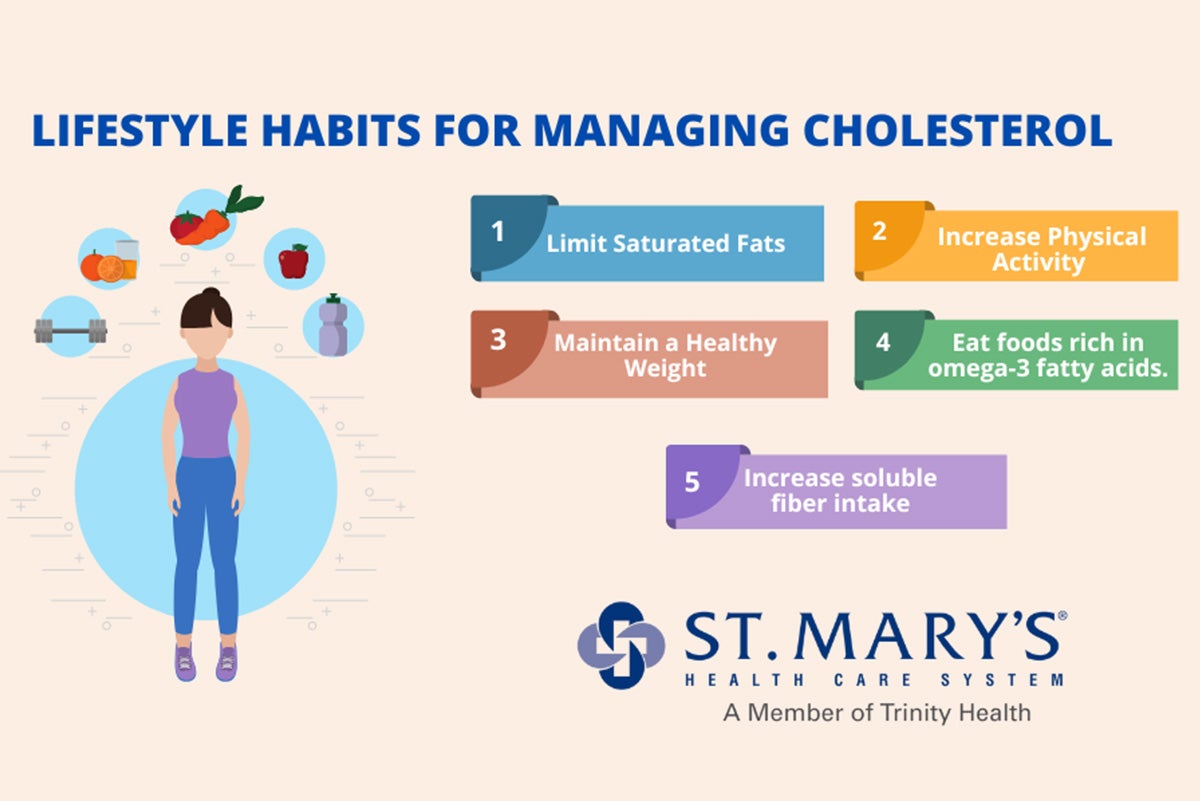Lifestyle Habits for Managing Cholesterol
September 11, 2023High blood cholesterol levels can cause buildup of plaque within arteries.
Cholesterol is a waxy, fat-like substance that is vital for various bodily functions and processes, including the production of cell membranes, hormones, creation of bile in the liver, and production of vitamin D, to name a few!
However, an unhealthy level of cholesterol – high cholesterol, also known as hypercholesterolemia – is a medical condition that can cause serious health problems. It is diagnosed by a simple test that looks for elevated levels of cholesterol in the blood.
High blood cholesterol levels can cause buildup of plaque within arteries, which can increase the risk of severe medical issues such as heart attack and stroke. Mayo Clinic, The American Heart Association, and the National Institutes of Health have defined and outlined healthy lifestyle habits that can be implemented in order to manage cholesterol levels.
What are the two types of cholesterol?
First off, in order to implement healthy lifestyle habits for managing and preventing high cholesterol, it is important to know there are two types of lipoproteins that are responsible for carrying cholesterol to and from cells. These lipoproteins are referred to as low-density lipoprotein (LDL) and high-density lipoprotein (HDL). A simple blood test is usually used to identify HDL and LDL levels within a person's blood.
LDL, also known as “bad cholesterol,” contributes to fatty buildups in arteries (atherosclerosis). This build-up causes the arteries to narrow, which forces the heart to work harder and increases the risk of heart attack, among other health issues.
HDL is often referred to as “good cholesterol.” HDL carries LDL cholesterol and plaque away from the arteries and back to the liver. In the liver, LDL can then be broken down and flushed from the body However, only one-third to one-fourth of blood cholesterol is carried by HDL.
What are some tips for managing cholesterol levels?
Limit saturated fats
Reducing the amount of saturated and trans fats in your diet is an imperative step in lowering an unhealthy blood cholesterol level. High consumption of foods containing saturated and trans fats leads your body to produce excess amounts of LDL, causing cholesterol to build up in the blood. Tactics to minimize saturated fat consumption include: choose lean meats with less than 10% fat, use less butter and margarine when cooking, and substitute low-fat alternatives (i.e., low fat cheeses, yogurts, etc.) for higher fat foods.
Physical activity
Consistent physical activity and avoiding excess sedentary behavior can assist with weight management, which can help reduce LDL cholesterol while simultaneously helping raise HDL cholesterol. Through exercising and maintaining an active lifestyle, your body can begin to naturally moderate cholesterol levels. The Department of Health and Human Services recommends at least 150 minutes a week of moderate activity, such as walking.
Maintaining a healthy weight
Physical activity and obesity are two elements of health that typically go hand in hand, including with managing healthy cholesterol levels. Being overweight or obese significantly increases the chances of having high LDL cholesterol and developing high blood pressure, among other serious health issues.
Eat foods rich in omega-3 fatty acids
Omega-3 fatty acids are a nutrient derived from food and are crucial for many human functions, including muscle movement and hormone production. While omega-3 fatty acids do not affect LDL cholesterol level, they are thought to aid in lowering triglycerides and increasing HDL!
Fatty fish are known to have high levels of omega-3 fatty acids, which can reduce your triglycerides. Specifically, high levels of omega-3 fatty acids can be found in fish such as tuna, trout, and salmon. But even if you do not like fish, foods such as walnuts, flaxseed and canola oil also have small amounts of omega-3 fatty acids.
Increase soluble fiber intake
Dietary fiber presents many nutritional benefits. In fact, soluble fiber can help decrease your LDL cholesterol because it helps in reducing the absorption of cholesterol into your bloodstream. Five to 10 grams or more of soluble fiber a day is recommended to decrease your LDL cholesterol. Foods rich in soluble fiber include: Brussel sprouts, sweet potatoes, oatmeal and bananas.
Maintaining a healthy cholesterol level is crucial for wellbeing and prevention of many chronic diseases! Implementing healthy habits such as these on a daily basis can help decrease cholesterol levels and promote an overall healthy lifestyle.
How to get started
The first step toward better health is to partner with a primary care provider (PCP). A PCP is a physician or nurse practitioner who will perform your annual wellness checks and provide in-office sick care for years. They can assist you with diagnosis and treatment of short-term and long-term conditions, prescribe medications, order tests and refer you to specialists when needed.




